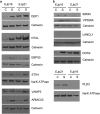Characterization of novel markers of senescence and their prognostic potential in cancer
- PMID: 25412306
- PMCID: PMC4260747
- DOI: 10.1038/cddis.2014.489
Characterization of novel markers of senescence and their prognostic potential in cancer
Abstract
Cellular senescence is a terminal differentiation state that has been proposed to have a role in both tumour suppression and ageing. This view is supported by the fact that accumulation of senescent cells can be observed in response to oncogenic stress as well as a result of normal organismal ageing. Thus, identifying senescent cells in in vivo and in vitro has an important diagnostic and therapeutic potential. The molecular pathways involved in triggering and/or maintaining the senescent phenotype are not fully understood. As a consequence, the markers currently utilized to detect senescent cells are limited and lack specificity. In order to address this issue, we screened for plasma membrane-associated proteins that are preferentially expressed in senescent cells. We identified 107 proteins that could be potential markers of senescence and validated 10 of them (DEP1, NTAL, EBP50, STX4, VAMP3, ARMX3, B2MG, LANCL1, VPS26A and PLD3). We demonstrated that a combination of these proteins can be used to specifically recognize senescent cells in culture and in tissue samples and we developed a straightforward fluorescence-activated cell sorting-based detection approach using two of them (DEP1 and B2MG). Of note, we found that expression of several of these markers correlated with increased survival in different tumours, especially in breast cancer. Thus, our results could facilitate the study of senescence, define potential new effectors and modulators of this cellular mechanism and provide potential diagnostic and prognostic tools to be used clinically.
Figures







References
Publication types
MeSH terms
Substances
Grants and funding
LinkOut - more resources
Full Text Sources
Other Literature Sources
Medical
Research Materials
Miscellaneous

